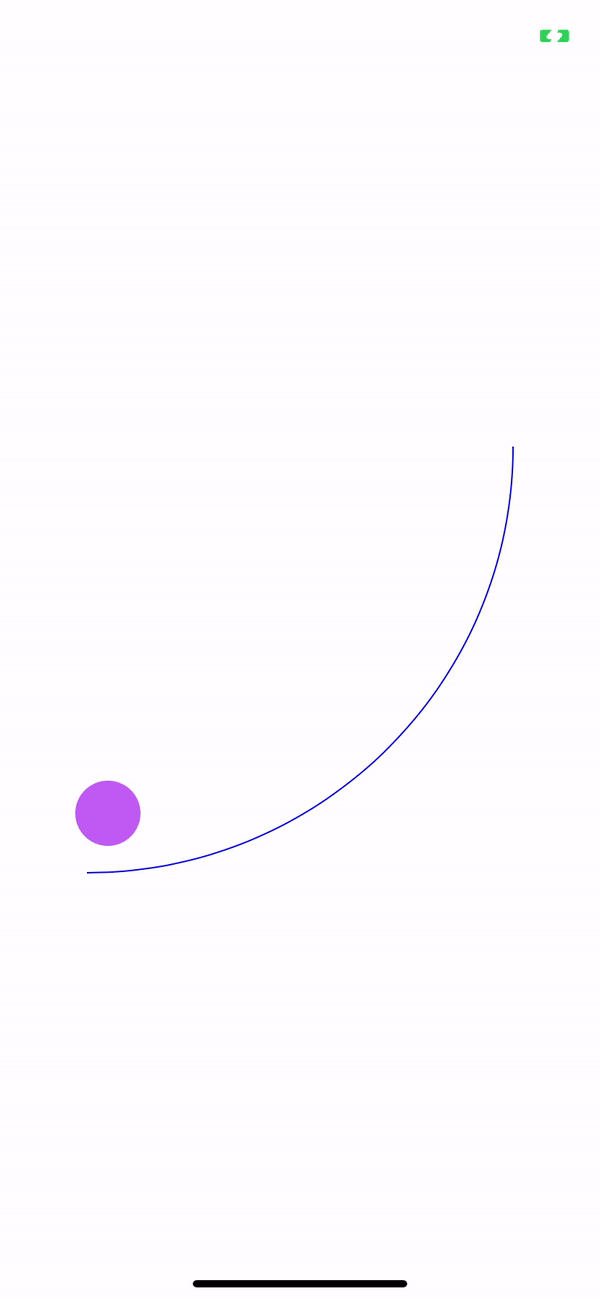Bit stumped here.
First of all, here is what’s going on:
As you can see, my ball is not following the curved quarter-circle path exactly, but vaguely.
Here is the code creating the quarter-circle (p.s. – my container view is 294 units tall and wide):
let startAngle = CGFloat(Double.pi * 2) // top of circle
let endAngle = startAngle + 2 * Double.pi * 0.25
view.layoutIfNeeded()
smallCircleView.parentVC = self
smallCircleView.layer.cornerRadius = 45/2
let circlePath = UIBezierPath(arcCenter: CGPoint(x: 0, y: 0), radius: containerView.frame.self.width, startAngle: startAngle, endAngle: endAngle, clockwise: true)
And here is the code shifting the ball around:
func shiftSmallCircleView(newX : CGFloat){
smallCircleViewLeadingConstraint.constant = newX
let angle = (newX/containerView.frame.self.width)*90 + 180
let y = containerView.frame.size.width * cos((Double.pi * 2 * angle) / 360)
smallCircleViewBottomConstraint.constant = y + containerView.frame.origin.y
}
Since I’m using the cos function, should the ball’s path be identical to the original quarter-circle path? How can they be similar but not identical?
Edit:
New outcome with updated code:
let angle = (distanceDelta/containerView.frame.self.width) * -90.0
containerView.transform = CGAffineTransform.init(rotationAngle: angle * Double.pi/180)
let angle = (distanceDelta/pathContainerView.frame.self.width) * .pi / -180.0
containerView.transform = CGAffineTransform.init(rotationAngle: angle)
All code:
class SmallCircleView : UIView {
var parentVC : ViewController!
override func touchesBegan(_ touches: Set<UITouch>, with event: UIEvent?) {
if let touch = touches.first as? UITouch {
let point = touch.location(in: self)
}
super.touchesBegan(touches, with: event)
}
override func touchesMoved(_ touches: Set<UITouch>, with event: UIEvent?) {
if let touch = touches.first as? UITouch {
let point = touch.location(in: self.superview)=
parentVC.shiftSmallCircleView(distanceDelta: point.x)=
}
}
}
class ViewController: UIViewController {
@IBOutlet var containerView : UIView!
@IBOutlet var pathContainerView : UIView!
@IBOutlet var smallCircleView : SmallCircleView!
@IBOutlet var smallCircleViewLeadingConstraint : NSLayoutConstraint!
@IBOutlet var smallCircleViewBottomConstraint : NSLayoutConstraint!
override func viewDidLoad() {
super.viewDidLoad()
// Do any additional setup after loading the view.
let startAngle = CGFloat(Double.pi * 2) // top of circle
let endAngle = startAngle + 2 * Double.pi * 0.25
view.layoutIfNeeded()
smallCircleView.parentVC = self
smallCircleView.layer.cornerRadius = 45/2
let circlePath = UIBezierPath(arcCenter: CGPoint(x: 0, y: 0), radius: pathContainerView.frame.self.width, startAngle: startAngle, endAngle: endAngle, clockwise: true)
let shapeLayer = CAShapeLayer()
// The Bezier path that we made needs to be converted to
// a CGPath before it can be used on a layer.
shapeLayer.path = circlePath.cgPath
// apply other properties related to the path
shapeLayer.strokeColor = UIColor.blue.cgColor
shapeLayer.fillColor = UIColor.white.cgColor
shapeLayer.lineWidth = 1.0
shapeLayer.position = CGPoint(x: 0, y: 0)
// add the new layer to our custom view
pathContainerView.layer.addSublayer(shapeLayer)
containerView.bringSubviewToFront(smallCircleView)
}
func shiftSmallCircleView(distanceDelta : CGFloat){
let degrees = min(1, (distanceDelta/pathContainerView.frame.size.width)) * -90
containerView.transform = CGAffineTransform.init(rotationAngle: degrees * M_PI/180)
}
}







2
Answers
I’m on my phone right now and so I can’t provide the code but there is a much much easier way to do this. Don’t bother trying to work out what coordinates the ball needs to be at. Just place the ball into a rectangular view with the centre of this view being at the centre of your circle and the ball being on the path. (Make the container view invisible).
Now… rotate the container view.
That’s it.
Because the ball is a child of the view it will be moved as part of the rotation. And the movement will follow a circle centred around the point of rotation. Which is the centre of the container view.
Example
I made a quick example to show what I mean. In essence… cheat. Don’t actually do the hard maths to work out where the ball will be. Use methods to make it look the same in an easier way…
Here is my storyboard…
And the code…
And an animation…
And if you make the container background clear…
To answer your original question…
I haven’t double-checked your math, but this is another method of positioning your "small circle" view.
Using these two "helper" extensions:
We can find the point on the arc for a given angle like this:
We can then move the "ball" to that point:
To get the circle view to "roll along the inside" of the arc, we use the same center point, but decrease the radius of the arc by the radius of the circle (half the width of the view).
If you want to use that approach (rather than rotating a view with the circle in the corner), here is some example code.
Start with our extensions, an enum, and a "small circle view":
Next, a
UIViewsubclass that will handle drawing the arc, adding the circle subview, and it will use aUIViewPropertyAnimatorwith key frames to make it interactive:and an example controller class:
The result:
Edit
After playing around a bit, this is another way to interactively follow the path — it uses layer path animation, and avoids the need to manually calculate keyframe positions.
Works with the same sample view controller as above – just replace the
FollowArcViewclass: